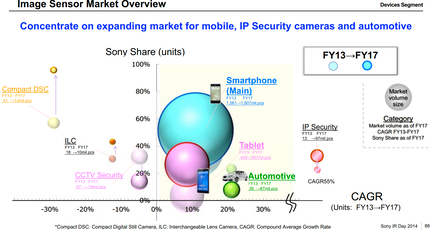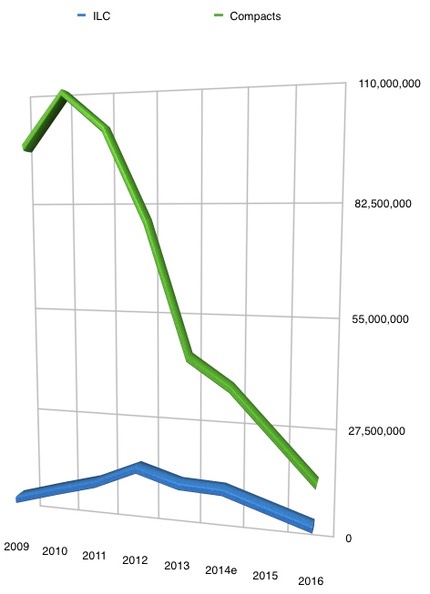Sony’s financial presentation last week in Japan caught a lot of attention, but I was a little surprised that no one really commented much on this slide:

Look at where all that sensor production growth Sony thinks is coming, and the size of those markets compared to cameras. Automotive use alone eclipses the camera market we currently know, and by a substantive amount (3x the sensor unit sales).
I’m sure that Sony fanboys reading the chart might notice and jump up and down about one aspect: near 100% market share in Compact DSC sensor sales. Heck, if you do the math properly, they’re also projecting near 100% capture of the non-Canon ILC market, too.
But look at the numbers much more carefully. Much. More. Carefully.
Compact sensor sales: down 38m units in four years to only 13m units.
DSLR/Mirrorless sensor sales: down 8m units in four years to only 10m units.
So while Sony might end up with near 100% of all the camera sensor sales outside of Canon if that chart comes true, it also means this:

Yeah, that’s Sony’s estimate of the camera sensor market through March 2017 tacked onto the CIPA numbers through 2013. You’d think that they’d be in a good position to know.
What this means is that the salmon heading upstream…uh, I mean camera makers heading upscale…will continue, and they’ll probably even head more upscale. Just to stay at the same revenue levels as this year the camera makers would probably have to increase their average selling prices 2x or so just to hold ground. Look out Leica, you’re going to have company.
It also explains Nikon’s push to FX. Same body, more money (e.g. D610 versus D7100). Thus at least revenues continue to look good, though you have to work hard to keep profit margin equal.
This makes Sony’s recent aggressive pricing (e.g. US$1300 for an A7) seem all the more wacky. In essence, they’re trying to buy market share before the collapse of the market becomes even more of a problem for them. Personally, if I were running the Sony camera group, I’d be looking at the semiconductor group’s estimates and deciding to wear Depends to work.
One small additional bit: mirrorless sales have been essentially flat for two years at the 3.3m unit mark, so 10m ILC cameras implies 6.7m DSLRs unless something changes that boosts mirrorless sales. This may be Sony’s intention with aggressive pricing, actually. Trying to tip the balance to mirrorless and put Canon/Nikon off balance in dealing with their decline. Note that Nikon’s current year projection is about 4.5m DSLRs (Canon’s is higher). The question is whether Nikon can hold their 33% market share in ILC. If they do, that implies ~3.3m DSLRs/Mirrorless sales for them in 2016 according to Sony’s forecast, or a drop of about 26% in unit volume.
That’s not to say that cameras won’t keep selling. They’ll just be in phones, tablets, computers, cars, and security devices. Heck, Samsung will probably add them to washers and dryers. Maybe I’ll someday have a ToasterCam in my kitchen so I can see when my muffins are done. Canon has already indicated that they want to get more into the security camera game, so they’ve sent an early warning signal that they’re willing to switch horses. Nikon has been totally silent on the matter and seems content to let Tokyo investors think that they’ll be a medical company some day. Pentax is probably still trying to figure out who they report to ;~).
Seriously, this is not good news. It means that the constant iteration we’ve been seeing must slow down, and in slowing down that will just slow down camera sales, too. At the moment, absolutely nothing is breaking the spiral downward towards the ground.
I get no joy in reporting and interpreting such news. With time, money, and the right team, I think the spiral can be broken. But as I’ve been pointing out for years now (maybe a decade?), the real user problems have to be tackled to do so. It is not solving a real user problem any more to add a stop of dynamic range or even double the pixel count. It’s not a real user problem solution to add more controls and more items on menus. It’s not a real user problem that’s motivating the push to higher video frame rates and compression quality into levels not even used in broadcast. Those things tend to address problems only a few need solved; for the rest of the market those are faux problems that “can maybe be marketed as a desirable feature.” Only the marketing isn’t working so well any more.
(Note that I wouldn’t turn my back on more dynamic range, more pixels, or better video, nor should you. It’s just that those aren’t the things that will truly make your camera use go up and compel you to completely replace what you’ve got. You might bite if you’re due for and have budgeted an update, or perhaps hit the lottery. But will you actually take better pictures with a D810 than you did with a D700? For most people, probably not. So why would you expect to take better pictures with tomorrow's D900?)
If camera sales continue to plunge as Sony expects, this has implications on everyone. A store like B&H might survive because they sell a lot more than cameras, plus they cater to the NY pro media market. But smaller brick and mortar dealers? Going to be even harder to find. Web sites counting on advertising and affiliate income to cover their content creation? A few will survive, but I should point out that 3% (affiliate referral income) of a market half the size is like 1.5% today. Software? A lot of it will head for the mobile devices (actually already has; the big signal on that was when Google bought Nik).
The good news is this: we’ve got remarkably good cameras these days. You can do tons of things with them image-wise that you couldn’t do 20 years ago. A few makers will hold on and make a few more great products, much as we saw in the high fidelity market when it collapsed like this.
So it’s time to just go out and enjoy what we have. Sure, buy something today on Cyber Monday if you wish, but try to wean yourself off the credit-card-as-therapy trip and just go shoot some pictures this week, okay? Let’s all try to remember that we’ve got an embarrassment of riches at our disposal. So let’s use them as intended.
I hereby declare this week “I’m done spending, I need to go shoot” week.





